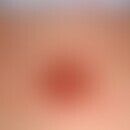DefinitionThis section has been translated automatically.
Half-lifeThis section has been translated automatically.
You might also be interested in
IndicationThis section has been translated automatically.
Notice! Before starting therapy, determine the glucose-6-phosphate dehydrogenase level. Women of childbearing age must have a negative pregnancy test before therapy and effective contraception protection must be provided during and up to 3 months after therapy! Smokers respond to the treatment significantly worse than non-smokers!
Dosage and method of useThis section has been translated automatically.
- Malaria therapy:
- Initially 800 mg p.o., then after 6, 12 and 24 hours 400 mg each. In very severe cases 5-day treatment: 2 days each 800 mg, 3 days each 400 mg.
- Children: Initial 13 mg/kg bw. 6, 12 and 24 hours later 6.5 mg/kg bw each.
- Malaria prophylaxis:
- 2 times 400 mg within 1 week before travel or on 2 consecutive days at travel start, then continue 400 mg 1 time/week on the same day of the week until 4 weeks after exposure.
- Children: Initial 2 times 6.5 mg/kg bw, then 6.5 mg/kg bw on the same day of the week.
- Lupus erythematosus and rheumatoid arthritis: Initially 400 mg/day for 4-8 weeks, then 200 mg/day and further reduction according to findings.
- Reticular erythematous mucinosis: 200 mg/day for 4 weeks, 100 mg/day for another 4 weeks, then further tapering.
- Porphyria cutanea tarda: 100 mg 3 times/week.
Undesirable effectsThis section has been translated automatically.
InteractionsThis section has been translated automatically.
Concomitant treatment with hydroxychloroquine and the following medicinal products may lead to drug interactions:
Digoxin: increased levels of digoxin possible.
Halofantrine: prolongation of the QT interval and increased risk of ventricular arrhythmias possible.
Arrhythmogenic drugs (e.g. amiodarone): increased risk of ventricular arrhythmias.
Ciclosporin: increased plasma levels of ciclosporin have been reported.
Seizure threshold-lowering agents (e.g., mefloquine) → efficacy of some anticonvulsants may be impaired with concomitant use of hydroxychloroquine, as hydroxychloroquine may lower the seizure threshold
Praziquantel: chloroquine may reduce the bioavailability of praziquantel
Agalsidase: theoretical risk of inhibition of intracellular α-galactosidase activity
Phenylbutazone: likelihood of exfoliative dermatitis increases
Hepatotoxic substances (caution with alcohol in large quantities) and MAO inhibitors.
Probenecid or indomethacin: increased risk of sensitization and retinopathy
Corticosteroids: myopathies or cardiomyopathies may be increased
Aminoglycosides: increased neuromuscular blockade possible
Pyrimethamine/sulfadoxine: risk of skin reactions significantly increased
Folic acid antagonists(methotrexate): their effect is increased
Ampicillin: absorption of ampicillin may be reduced
Neostigmine or pyridostigmine: the effect of neostigmine or pyridostigmine may be reduced
antacids: may decrease the absorption of hydroxychloroquine
cimetidine: may delay the excretion of hydroxychloroquine
PreparationsThis section has been translated automatically.
PatientinformationThis section has been translated automatically.
Remember! It should be taken after meals.
LiteratureThis section has been translated automatically.
- Jewell ML et al (2000) Patients with cutaneous lupus erythematosus who smoke are less responsive to antimalarial treatment. J Am Acad Dermatol 42: 983-987




